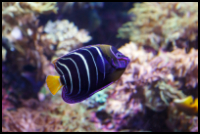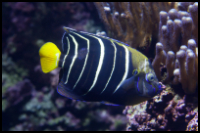


Quick Care Details (Table)
| Livestock Characteristics | Value |
|---|---|
| Care Level | Moderate |
| Temperament | Semi-Aggressive |
| Diet | Omnivore |
| Maximum Size | 1ft & 1 Inches |
| Minimum Tank Size | 220 Gallons |
| Reef Compatible | With Caution |
| Temperature Range | 72-78F |
| PH Range | 8.1-8.4 |
| DKH Range | 8-12 |
| Salinity Range | 1.020-1.025 |
Species Specific Categories
Helpful Video
Care Details
Aquascape: When setting up a tank for Chrysurus Angelfish, it's essential to create a habitat that resembles their natural reef environment. Use live rock formations with nooks and crannies for hiding spots, while still leaving open swimming areas. Including live corals is an option, but be selective, as they might nip at some corals.
Substrate: A sandy substrate mimics their natural habitat and allows them to sift through the sand in search of food. It's a practical and visually pleasing choice.
Disease Prevention: To keep your Chrysurus Angelfish healthy, maintaining top-notch water quality is a must. Regular water changes, a well-rounded diet, and quarantine for new fish additions can help prevent common aquarium diseases.
Filtration: Invest in a robust filtration system to ensure stable water conditions. A protein skimmer can help eliminate organic waste and maintain water quality.
Lighting: Chrysurus Angelfish often inhabit brightly lit reef environments, so moderate to high-intensity lighting is appropriate, especially if you have corals in the tank.
Water Flow: These angelfish appreciate some water movement. Use powerheads or circulation pumps to create natural water flow patterns, which oxygenate the water and promote a healthier environment.
Hardiness: Chrysurus Angelfish are moderately hardy but thrive in well-established aquariums with stable water conditions.
Acclimation: When introducing a new Chrysurus Angelfish, a gradual acclimation process is essential to reduce stress. Drip acclimation is a commonly used method to help them adjust to the new environment.
Expected Lifespan: With proper care and attention to diet and tank conditions, Chrysurus Angelfish can live for 10-15 years or even longer.
Special Requirements: Pay attention to their territorial behavior when selecting tank mates. Chrysurus Angelfish may show aggression towards similar-looking species. Ensure a balanced diet that includes algae and sponge-based foods to maintain their health and vibrant coloration.
Temperament and Behavior
Behavior and Social Interaction: Chrysurus Angelfish are generally peaceful fish, making them great additions to community reef tanks. They have an inquisitive nature and are often seen exploring their environment and investigating nooks and crannies. While they can be a bit territorial, especially with similar-looking species, they tend to interact peacefully with other tank mates.
Aggression: Chrysurus Angelfish are relatively mild-mannered, but they might exhibit territorial behavior, particularly towards conspecifics or other angelfish species. It's essential to provide them with enough space and hiding spots to reduce potential conflicts.
Breeding: Breeding Chrysurus Angelfish in captivity can be challenging, and they are not typically bred in home aquariums. They engage in external fertilization, where the male fertilizes the eggs released by the female. Successful breeding may require specific conditions, including proper diet, water parameters, and a well-structured breeding tank.
Compatibility with Inverts and Fish: Chrysurus Angelfish can coexist with a range of tank mates, including peaceful fish species and many invertebrates. However, exercise caution when introducing them to similar-looking angelfish species or very territorial fish, as territorial disputes can arise.
Activity Level: These angelfish are active swimmers. They tend to explore their surroundings and spend time picking at rocks and substrates in search of small food items, making them a joy to observe in the aquarium.
Clean-Up Crew: While they regularly eat algae they might also eat coral. Chrysurus Angelfish are a great cleanup crew member.
Schooling or Shoaling Behavior: Chrysurus Angelfish are not known for schooling or shoaling behavior. They prefer to swim independently or occasionally in small groups. Providing adequate hiding spots can help them feel secure.
Coral Reef Compatibility: Chrysurus Angelfish are considered reef-safe with some precautions. They may nip at certain soft and stony corals, so it's wise to carefully choose corals that are less likely to be targets of their nipping behavior. However, they generally coexist well with many reef inhabitants.
Diet and Nutrition
Dry Foods: Chrysurus Angelfish are typically open to accepting high-quality dry foods like angelfish pellets, flakes, and small marine pellets. It's a convenient and balanced option to include in their diet. Look for foods designed specifically for marine angelfish.
Frozen Foods: They also relish frozen foods like brine shrimp, mysis shrimp, and finely chopped seafood. These foods provide essential nutrients and can be offered as a part of their varied diet.
Live Foods: Chrysurus Angelfish have a penchant for live foods like small crustaceans and zooplankton. Live foods not only provide essential nutrients but also stimulate their natural foraging behavior. Offer live foods occasionally to keep their diet diverse and engaging.
Algae: Chrysurus Angelfish may graze on algae, especially in well-established reef tanks with suitable algae growth. They are omnivores so you can add variety to their diet and can help mimic their natural feeding behaviors.
Feeding Schedule: Offer small, frequent feedings throughout the day to replicate their natural feeding patterns. A schedule of 2-3 feedings per day is generally suitable. Ensure that they consume their meals within a few minutes to prevent overfeeding and water quality issues.
Supplemental Foods: To enhance their nutrition and vibrant coloration, consider supplementing their diet with vitamin-enriched and color-enhancing foods. These are available in both dry and frozen forms. Providing occasional treats like live brine shrimp or Mysis shrimp can also keep their diet exciting.
Tank Parameters
Tank Size: A suitable tank size for a single Chrysurus Angelfish should be a minimum of 75 gallons (around 284 liters). For multiple angelfish or if you intend to keep them with other fish, consider a larger tank to provide ample swimming space.
Tank Length and Measurements: The tank dimensions for a 75-gallon tank are typically around 48 inches (122 cm) in length, 18 inches (46 cm) in width, and 20 inches (51 cm) in height. These dimensions provide sufficient room for the angelfish to swim comfortably.
Species Maximum Size: Chrysurus Angelfish can grow up to about 12 inches (30 cm) in length when fully mature. Keep this in mind when planning your tank size, as they require space to accommodate their adult size.
Water Temperature: Maintain the water temperature in the range of 72-78°F (22-26°C). This temperature range mimics their natural habitat and ensures their well-being.
pH (Acidity/Alkalinity): Chrysurus Angelfish thrive in water with a pH level between 8.1 and 8.4. This slightly alkaline range is suitable for their health and vitality.
Nitrate (NO3) Levels: Keep nitrate levels in check, ideally below 20 ppm (parts per million). Regular water changes and efficient filtration can help maintain these levels.
Salinity: Maintain a specific gravity (salinity) between 1.020 and 1.025. This range is typical for marine aquariums and ensures that the fish's osmoregulation functions properly.
Phosphate (PO4): Phosphate levels should be relatively low, ideally below 0.2 ppm. Elevated phosphate levels can lead to algae issues and should be avoided.
Alkalinity (dKH): The alkalinity, measured in dKH (degrees of carbonate hardness), should be maintained between 8 and 12 dKH. This range contributes to stable water conditions and the health of your Chrysurus Angelfish.
History, Popularity, History and Species Variety Details
The History, Popularity and Natural Habitat
History: The Chrysurus Angelfish, scientifically known as Pomacanthus chrysurus, has a fascinating history rooted in the warm waters of the Atlantic Ocean. While their exact discovery date remains a bit of a mystery, they've been admired in the marine aquarium community for a considerable time. These stunning angelfish have enchanted marine enthusiasts for generations.
Popularity: Chrysurus Angelfish are prized in the aquarium world for their captivating appearance. Their vibrant yellow and electric blue colors make them a favorite among both seasoned hobbyists and newcomers. What adds to their charm is their peaceful temperament, making them an ideal choice for a wide range of marine tanks.
Natural Habitat: In their natural environment, Chrysurus Angelfish call the warm, tropical waters of the Caribbean Sea and the Gulf of Mexico their home. They thrive in coral reefs, rocky formations, and crystal-clear waters, often seeking shelter among the corals and rocks. Their diet consists of small invertebrates, zooplankton, and algae, contributing to the ecological balance of their coral reef habitats.
These angelfish play a vital role in the underwater world, contributing to the health and diversity of their coral reef ecosystems. Their enduring popularity in the aquarium hobby is a testament to their striking beauty and adaptability, making them a cherished addition to many marine aquariums.
- French Angelfish (Pomacanthus paru): The French Angelfish boasts a striking coloration with dark bodies and vivid yellow stripes, similar to the Chrysurus Angelfish. They share the same family but differ in their patterns. French Angelfish are commonly found in the western Atlantic Ocean.
- Gray Angelfish (Pomacanthus arcuatus): Gray Angelfish have a more subdued coloration than the Chrysurus Angelfish, with gray bodies and faint yellow markings. They also belong to the Pomacanthidae family and inhabit the western Atlantic Ocean.
- Emperor Angelfish (Pomacanthus imperator): Emperor Angelfish are close relatives of the Chrysurus Angelfish, known for their vibrant colors and blue and yellow stripes. They are often seen in the Indo-Pacific region and the Red Sea.
- Majestic Angelfish (Pomacanthus navarchus): These angelfish are characterized by their striking blue and yellow coloration, similar to the Chrysurus Angelfish. Majestic Angelfish are native to the western Pacific Ocean and the Great Barrier Reef.
- Bicolor Angelfish (Centropyge bicolor): If you're looking for a smaller, reef-safe alternative, the Bicolor Angelfish is a popular choice. They have a striking half-blue and half-yellow body and are known for their peaceful nature.
Frequently Asked Questions
What is the Chrysurus Angelfish's typical size in captivity?
Chrysurus Angelfish can grow to about 10-12 inches (25-30 cm) in a well-maintained aquarium.
Are they suitable for beginners in the aquarium hobby?
While their peaceful nature makes them a decent choice for beginners, their larger tank size requirements and specific care needs may make them better suited for intermediate or experienced aquarists.
Can I keep Chrysurus Angelfish in a reef tank?
They will generally not be a good reef addition, due to their common behavior to eat coral.
Are Chrysurus Angelfish prone to diseases?
Proper water quality, regular maintenance, and quarantine for new additions can help prevent common aquarium diseases. They are also very susceptible to Ich and Velvet due to their thin slime coat.
What's the typical lifespan of Chrysurus Angelfish in captivity?
With proper care, they can live for 10-15 years or even longer.
How can I maintain the health and vibrant coloration of my Chrysurus Angelfish?
Regular feeding, providing diverse foods, and maintaining excellent water quality are key to their health and coloration.
Can I keep them with other angelfish species?
Exercise caution when housing them with similar-looking angelfish, as territorial disputes may arise.

